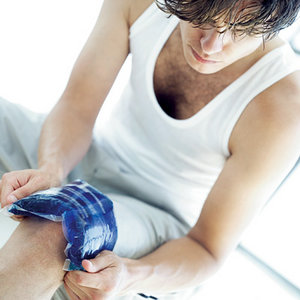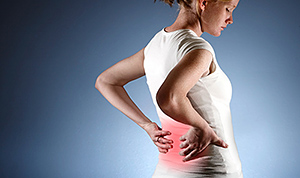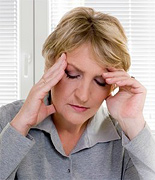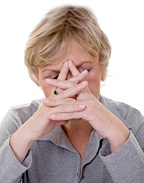Wednesday, August 13, 2014
Low Back Pain: Why Is It So Common?
This question has plagued all of us, including researchers for a long time! Could it be because we’re all inherently lazy and don’t exercise enough? Or maybe it’s because we have a job that’s too demanding on our back? To properly address this question, here are some interesting facts:
1. The prevalence of low back pain (LBP) is common, as 70-85% of ALL PEOPLE have back pain that requires treatment of some sort at some time in life.
2. On a yearly basis, the annual prevalence of back pain averages 30% and once you have back pain, the likelihood of recurrence is high.
3. Back pain is the most common cause of activity limitation in people less than 45 years of age.
4. Back pain is the 2nd most frequent reason for physician visits, the 5th ranking reason for hospital admissions, and is the 3rd most common cause for surgical procedures.
5. About 2% of the US workforce receives compensation for back injuries annually.
6. Similar statistics exist for other countries, including the UK and Sweden.
So, what are the common links as to why back pain is so common? One reason has to do with the biomechanics of the biped – that is, the two legged animal. When compared to the 4-legged species, the vertically loaded spine carries more weight in the low back, shows disk and joint deterioration and/or arthritis much sooner, and we overload the back more frequently because, well, we can! We have 2 free arms to lift and carry items that often weigh way too much for our back to be able to safely handle. We also lift and carry using poor technique. Another reason is anatomical as the blood supply to our disks is poor at best, and becomes virtually non-existent after age 30. That makes healing of disk tears or cracks nearly impossible. Risk factors for increased back injury include heavy manual lifting requirements, poor or low control of the work environment, and prior incidence of low back pain.
Other risk factors include psychosocial issues such as fear of injury, beliefs that pain means one should not work, beliefs that treatment or time will not help resolve a back episode, the inability to control the condition, high anxiety and/or depression levels, and more. Because there are so many reasons back problems exist, since the early 1990’s, it has been strongly encouraged that we as health care providers utilize a “biopsychosocial model” of managing those suffering with low back pain, which requires not only treatment but proper patient education putting to rest unnecessary fears about back pain.
Wednesday, July 30, 2014
Neck Pain – Can Chiropractic Really Help?
Neck pain is a very common problem affecting up to 70% of the adult population at some point in life. Though there are specific causes of neck pain such as arising from a sports injury, a car accident or “sleeping crooked,” the vast majority of the time, no direct cause can be identified and thus the term nonspecific is applied. There are many symptoms associated with patients complaining of neck pain and many of these symptoms can be confused with other conditions. Wouldn’t it be nice to know what neck related symptoms are most likely to respond to chiropractic manipulation before the treatment has started? This issue has been investigated with very favorable results!
The ability to predict a favorable response to treatment has been termed, “clinical prediction rules” which in general, are usually made up of combinations of things the patient says and findings from exams. In a large study, data from about 20,000 patients receiving about 29,000 treatments, was collected and analyzed to find out what complaints responded well to chiropractic treatment. The results showed that the presence of any 4 of these 7 presenting complaints predicted an immediate improvement in 70-95% of the patients: 1. Neck pain; 2. Shoulder, arm pain; 3. Reduced neck, shoulder, arm movement; 4. Stiffness; 5. Headache; 6. Upper, mid back pain, and 7. None or one presenting symptom. Items not associated with a favorable immediate response included “numbness, tingling upper limbs,” and “fainting, dizziness and light-headedness in 4-12% of the patients. The “take-home” message here is that was far more common to see a favorable response (70-95%) of the patients compared to an unfavorable response (4-12%), supporting the observation that most patients with neck complaints will respond favorably to chiropractic treatment.
So, what do we do as chiropractors when a patient presents with neck pain? First, after gathering preliminary information such as name, address and insurance information, a history of the presenting complaint is taken. This consists of information including what started the neck complaint (if you know), when it started, what makes it worse, what makes it better, the quality of pain (aches, stiff, numb, etc.), the location and if there is radiating complaints, the severity (0-10 pain scale), timing (such as worse in the morning, evening, etc.), and if there have been prior episodes. Various questionnaires are included that are scored so improvement down the road can be tracked and a past history that includes a medication list, past injuries or illnesses, family history and a systems review are standard. The exam includes vital signs (BP, pulse, height, weight, temperature and respiration), palpation, range of motion, orthopedic and neurological examination. X-ray and/or other “special tests” may also be included, when needed. A review of all the findings are discussed and after permission to treat is granted, a chiropractic adjustment may then be rendered. A list treatment options may include:
1. Adjustments;
2. Soft tissue therapy (trigger point stimulation, myofascial release);
3. Physical therapy modalities;
4. Posture correction exercises and other exercises/home self-administered therapies;
5. Education about job modifications;
6. Co-management with other health care providers if/when needed.
Wednesday, July 2, 2014
When to Use Ice and Heat
Here's a question I get asked all the time... "Ice or Heat?"
You're at the park on a glorious Saturday morning playing a friendly game of basketball with your fellow weekend warriors. You jump for a rebound and land awkwardly, twisting your knee, and drop to the ground in pain. Moments later, you've been helped off the court by teammates and are watching your knee slowly but surely start to swell.
What should you do next? Too many people essentially shrug off the pain and return to the game after a few minutes of "rest," hoping everything will return to normal. That attitude can turn a simple strain or sprain into a chronic injury that limits your activities for weeks or even months.
When joint and muscle injuries occur, immediate application and continuation of first aid is vital. Delayed or incorrect first aid will slow the healing process dramatically. What do you do when you or someone you know suffers this type of injury? Here are a few things you can do immediately to start the healing process.
The R.I.C.E. Recovery Formula
 Remembering the acronym R.I.C.E. is of great help whenever joint or muscle first aid is needed. The acronym stands for Rest, Ice, Compression and Elevation. Immediately following an injury involving the muscles or joints, these four steps should be taken:
Remembering the acronym R.I.C.E. is of great help whenever joint or muscle first aid is needed. The acronym stands for Rest, Ice, Compression and Elevation. Immediately following an injury involving the muscles or joints, these four steps should be taken:Resting an injured area reduces the stress and strain which, in turn, reduces the chance of further injury. When an injury occurs, immediately stop using the injured area.
Ice applied to an injured joint or muscle reduces swelling and bleeding by slowing blood flow to the area.
Compression (wrapping or taping the area of injury) reduces swelling and gives extra support to injured tissues. Compression applies primarily to the extremities (arms and legs).
Elevation of the injured body part above the level of the heart slows blood flow to the area by forcing the heart to pump "uphill." Reducing blood flow reduces swelling. Elevation applies primarily to injuries involving the extremities (arms, legs, feet and hands).
Heat or Cold: Which to Use?
Actually, heat and cold are both important components of recovery following an injury, but it's important to understand which to use and how to achieve maximum benefit. Remember these general rules when considering whether to apply ice or heat:
Applying Ice Properly
 WHEN: Ice or gel packs are the first choice of care during the first 48-72 hours following injury.
WHEN: Ice or gel packs are the first choice of care during the first 48-72 hours following injury. HOW: The application of ice directly to an injured or painful area of the body can be quite a shock at first. To avoid this, apply the ice pack as follows: Apply the ice, or gel pack over a towel which will allow for a gradual cooling and more comfort. Place the towel under hot (but not scalding) running water, wring out the excess water and place the towel on the affected area.
FREQUENCY: Each application of ice/gel packs should be 20-30 minutes, with 3-5 applications per day.
WARNINGS: Never apply ice for longer than 30 minutes at a time, and not at all if the injured party is suffering from any of the following: frostbite, areas of decreased sensation, Raynaud's disease, severe circulation problems, rheumatoid or gouty arthritis, or a worst-case scenario such as coma. Also do not use chemical ice bags that require shaking or have to be struck to be activated. Shaking and striking these bags may result in leakage of the active chemicals. The chemicals are usually caustic and may result in burns or other injuries.
Applying Heat Properly
 WHEN: Moist heat may be applied 48-72 hours after injury. Heat increases
circulation by dilating blood vessels and letting more blood into the
area.
WHEN: Moist heat may be applied 48-72 hours after injury. Heat increases
circulation by dilating blood vessels and letting more blood into the
area.HOW: Moist heat provides more soothing relief than dry heat. Gel packs, hot towels, hot baths, hot showers, whirlpools, steam saunas, and moist heating pads are examples of heat with moisture.
FREQUENCY: Each application of moist heat should be 20-30 minutes, with 3-5 applications per day.
WARNINGS: Never apply moist heat for longer than 30 minutes. Never sleep on a heating pad.
 Gel Packs: Two Treatments in One
Gel Packs: Two Treatments in OneThe most versatile piece of home therapy equipment you can own is a gel pack ( I have them for sale in the office if you can't find them on your own). Gel packs can be utilized for both cold and hot applications. Most are stored in the freezer until the need arises for cold application. If heat is needed, the pack can be transferred from the freezer to the microwave and heated as directed. Gel packs come in a variety of sizes and stay flexible at all temperatures. Constant flexibility allows the pack to be molded to the area of injury. Remember, it is always a good idea to place a towel between your skin and the gel pack.
Cut these instructions out and tape them on the inside of a medicine or kitchen cabinet so they will always be readily available whenever you or someone you know suffers a joint or muscle injury requiring first aid. Remember, the type, severity and circumstances surrounding the injury can impact the precise course of treatment to be pursued. For example, joint or bone deformity, uncontrollable bleeding associated with injury, loss of consciousness, loss of feeling in the area of injury, convulsions, etc., require immediate medical attention. Always consult with your doctor if you are unsure of the severity of an injury or if you have further questions regarding appropriate first-aid treatment.
Wednesday, June 18, 2014
Chiropractic for Sciatica
Sciatica is a condition in which pain radiates from the lower back
down one or both legs. This is generally caused by a problem in your
lower back. While many people believe that sciatica requires surgery, a
new study found that "sixty percent of patients with sciatica who had
failed other medical management benefited from spinal manipulation to
the same degree as if they underwent surgical intervention."
Chiropractic can alleviate many of the symptoms related to sciatica and can do a lot for those who are suffering. Given the potential dangers related to surgery, chiropractic spinal manipulation should be the first choice for those suffering from sciatica or any form of back pain.

The purpose of the study, published in PubMed was to compare the clinical efficacy of spinal manipulation against microdiskectomy in patients with sciatica secondary to lumbar disk herniation (LDH).
If you suffer from sciatica, make sure to talk to me (or your chiropractor) about your options for relief and healing.
Chiropractic can alleviate many of the symptoms related to sciatica and can do a lot for those who are suffering. Given the potential dangers related to surgery, chiropractic spinal manipulation should be the first choice for those suffering from sciatica or any form of back pain.

The purpose of the study, published in PubMed was to compare the clinical efficacy of spinal manipulation against microdiskectomy in patients with sciatica secondary to lumbar disk herniation (LDH).
If you suffer from sciatica, make sure to talk to me (or your chiropractor) about your options for relief and healing.
Wednesday, February 26, 2014
See a Chiropractor First to Avoid Back Surgery?
According to the Mayo Clinic, "back surgery is needed in only a small percentage of cases. Most back problems can be taken care of with nonsurgical treatments, such as anti-inflammatory medication, ice, heat, gentle massage and physical therapy." Accurate on face value, but missing an important piece of the puzzle. Yes, while back pain is rampant, surgery is rarely required; even the Mayo Clinic admits that while "back pain is extremely common ... surgery often fails to relieve it." However, chiropractic is glaringly absent from the nonsurgical recommendations, despite ample research evidence supporting chiropractic care for back pain and increasing reliance on chiropractic as a first-line treatment option.
So, what determines whether a patient undergoes spinal surgery? A recent study attempted to answer that very question and came up with several predictive variables, perhaps the most interesting of which is the type of health care provider – namely a surgeon or a doctor of chiropractic – the back pain patient sees first. The study authors, who note that "there is little evidence spine surgery is associated with improved population outcomes, yet surgery rates have increased dramatically since the 1990s," found that Washington state workers with an occupational back injury who visited a surgeon (orthopedic, neuro or general) first were significantly more likely to receive spine surgery within three years (42.7 percent of workers) than workers whose first visit was to a doctor of chiropractic (only 1.5 percent of workers). This association held true even when controlling for injury severity and other measures.
 Of the 174 workers (9.2 percent of the subject population) who had a
surgery during the three-year time frame, the vast majority were
decompression procedures (78.7 percent), with 3.4 percent undergoing
fusion without decompression and 17.8 percent undergoing both on the
same day.
Of the 174 workers (9.2 percent of the subject population) who had a
surgery during the three-year time frame, the vast majority were
decompression procedures (78.7 percent), with 3.4 percent undergoing
fusion without decompression and 17.8 percent undergoing both on the
same day.Something to think about...
Wednesday, February 12, 2014
Four Mistakes To Avoid In Any Stretching Program
As we age, our muscles tighten and range of motion in our joints decreases. This can impact even the most active lifestyle and hinder your normal day-to-day activities. Tasks that used to be simple, like zipping up a dress or reaching for a can off the top shelf, may become extremely difficult. A regular stretching program can help lengthen your muscles and make daily activities routine again.
The word flexible comes from the Latin word flexus, which means "to bend." Flexibility is the degree to which an individual muscle will lengthen. Stretching increases flexibility, which will help you perform daily activities and reduce the risk of muscle, joint and tendon injuries. Stretching also improves circulation, increasing blood flow to the muscles. Increased blood flow provides more nourishment to the muscles and gets rid of more waste by-products in the muscle tissue itself. Improved circulation can also help speed up recovery time if you suffer a muscle injury.
What's more, stretching can help eliminate or decrease low back pain, one of the most common kinds of structural pain, affecting a large percentage of the population. Muscle tightness in the quadriceps, hamstrings, hip flexors, and low back muscles is a common cause of low back pain. Stretching these muscles will often eliminate the pain. Keep in mind that every joint is tied to another joint, so if one muscle is tight, it is going to affect another joint or muscle.
One of the greatest benefits of stretching is that you're able to increase your range of motion, which means your joints can move further before an injury occurs. Stretching after you exercise (at least after you've warmed up a bit) has proven to be much more effective than pre-workout stretches, because by the time you've completed your workout, the muscles are "warm." Post-exercise stretching also helps reduce soreness, improves workout recovery, and ensures muscle and tendons are working properly.
There are no disadvantages to stretching - unless, of course, you do them improperly, which is actually easy to do if you don't know what you're doing. Here are the four mistakes to avoid in any stretching program:
DON'T bounce when stretching; hold your position for the specified time.
DON'T stretch cold muscles; always do some type of warm-up for at least five minutes: jogging in place, walking on a treadmill, light jump rope, etc.
DON'T overstretch. There should be a little discomfort, especially if you're not used to stretching, but it should not be painful.
DON'T stretch a muscle improperly. If you are not sure of the proper stretch or how to perform it, get some assistance from a professional.
Wednesday, January 29, 2014
Headache Help-- Treating the Top 5 Types of Headaches
Most of us can say we've experienced a headache. My question is: Do you know what type of headache you suffered and the best way to address it naturally?
Headaches are the most self-diagnosed and self-medicated dysfunction in the U.S., with an estimated half-billion dollars spent on headache cures in just the past year. More than 60 million people made a visit to the doctor's office last year because they thought their headache was severe enough to seek treatment, but only 2 percent of these were caused by brain tumors, hypertension or other serious conditions. Although we can differentiate between dozens of headaches, here are the top five, along with a few natural treatment options.
Cluster Headaches
Let's begin with a discussion of vascular headaches. Cluster headaches and migraines both are vascular in nature, which means the headache comes from within the cranium. A cluster headache is a stabbing pain that occurs on one side of the head, and often is local to one temple or behind one eye. These painful attacks occur every day or several times a day for weeks or months, and can last from 15 minutes to three hours.
 Men are more likely to suffer from cluster headaches. The first attack
of a cluster headache usually starts in patients 20-30 years of age.
Heavy smokers are more likely to suffer from cluster headaches, but
unlike migraine headaches, they are not familial (i.e., they do not run
in the family). Although this headache starts behind one eye, it may
radiate into the temple, nose, jaw, chin or teeth. One of the most
common signs is a drooping eyelid, as well as tearing or red eyes on the
side of the headache. Other symptoms include runny or stuffy nose and
facial sweating, which occur on the side of the pain.
Men are more likely to suffer from cluster headaches. The first attack
of a cluster headache usually starts in patients 20-30 years of age.
Heavy smokers are more likely to suffer from cluster headaches, but
unlike migraine headaches, they are not familial (i.e., they do not run
in the family). Although this headache starts behind one eye, it may
radiate into the temple, nose, jaw, chin or teeth. One of the most
common signs is a drooping eyelid, as well as tearing or red eyes on the
side of the headache. Other symptoms include runny or stuffy nose and
facial sweating, which occur on the side of the pain. The two types of cluster headaches are episodic and chronic. An episodic cluster headache is followed by a long-term remission that is pain-free. A chronic cluster headache has no more than a one-week, headache-free period within a year. Only 10 percent to 20 percent of all cluster headaches are chronic. Most can be treated by simply administering oxygen for 10-15 minutes and abstaining from alcohol, cigarettes and drugs. Since most people who suffer from cluster headaches do not have good sleep patterns, another way to prevent the cluster headache from occurring is to establish a routine sleep pattern.
Migraine Headaches
A migraine is not a simple headache, but a biochemical dysfunction that can affect the entire body. Although it might last 4-72 hours, it's not a daily headache. We differentiate between common and classic migraines. A classic migraine has five stages: prodrome, aura, headache, resolution and postdrome, whereas common migraine sufferers may not experience prodrome or aura.
Prodrome: More than half of all migraine sufferers will notice certain changes within 24 hours prior to their headache. These changes may include changes in mood, changes in sensory perception, memory problems, speech problems, craving of special foods and lack of oxygen resulting in yawning. These symptoms appear as a result of abnormal brain activity.
Aura: Anywhere from 10 minutes to an hour after the onset of a migraine, patients will feel certain changes. These may include irritability or restlessness, nausea or loss of appetite, and visual changes (i.e., flashing lights or colors, shimmering borders around objects). Some patients will experience "stroke-like" symptoms, which produce slurred speech, weakness, and numbness or "pins and needles" around the lips or hands.
 Headache: A migraine usually occurs on one side of the
head and is pulsating in nature. Although usually a unilateral headache
(i.e., occurring on one side of the head), a migraine may travel from
one side of the head to the other on another incident. Pain and
sensitivity in the muscles of the scalp and neck are common and sensory
stimuli, such as smells, light, touch or sound become irritants.
Headache: A migraine usually occurs on one side of the
head and is pulsating in nature. Although usually a unilateral headache
(i.e., occurring on one side of the head), a migraine may travel from
one side of the head to the other on another incident. Pain and
sensitivity in the muscles of the scalp and neck are common and sensory
stimuli, such as smells, light, touch or sound become irritants. Resolution: Often, after a period of rest, the headache will resolve and the body will return to normal functioning. Other events that might end the headache include vomiting or an emotional outburst.
 Postdrome: The migraine sufferer will feel fatigued,
tired and emotionally drained after the headache stops. Their actions
may be sluggish and they may feel achy all over.
Postdrome: The migraine sufferer will feel fatigued,
tired and emotionally drained after the headache stops. Their actions
may be sluggish and they may feel achy all over.Migraine treatment varies from person to person. While some use coffee to prevent a headache from occurring, others attribute their headache to the coffee they drank. In most cases, the anterior neck muscles (scalenous and sterno-cleido-mastoid, or SCM) are severely contracted. To relax these muscles, I recommend placing the relaxed four fingers of your opposite hand onto the front of the neck. Without creating any pressure on the muscles of the neck, simply shake the hand up and down for at least 30 seconds. The speed of your vibration does not have to be too fast - move your hand as though you were waving your hand goodbye to a friend. It is important that you do not compress the tissue because this compression will slow down the blood flow to your brain. This cranial circulation problem was the primary cause of the migraine headache in the first place. I would recommend (at most) two minutes of this vibration, which you can repeat throughout the day.
Sinus Headaches
Sinus headaches often are mistaken for migraine headaches because they occur behind one eye, but sinus headaches are not pounding in quality. You simply can press on the eyebrow area, where your sinuses are, to see if there is pain or discomfort. If you experience pain in this area, press on it with your index and middle finger. As you maintain pressure, move your fingers in a circular direction for 20-30 seconds. After a pause of 10-15 seconds, repeat this move one or two times. This intervention should encourage your sinuses to drain, so don't be surprised if you feel some post-nasal drip.
Chronic Daily Headaches
Chronic daily headache is a combination headache. It's a tension headache that superimposes itself onto the migraine headache - an excruciating combination. Although the severity of the headache leads many people to take heavy pain medications, the headache falls into the category of chronic dysfunction, not severe and acute pain (such as post-surgical), which makes pain pills problematic, not only because they are ineffective, but also because they are severely addictive. Instead, try a natural muscle relaxant like 250-500 mg of magnesium. Stress reduction techniques, chiropractic adjustments and other physiotherapy modalities might provide you with a better long-term solution as well.
Tension Headaches
Tension headaches are incredibly common, accounting for 90 percent of all headaches. They are caused by stress or tension in the neck, shoulders and head and are the headache most often addressed by chiropractic and massage therapy. Women are more prone to these types of headaches than men.
A tension headache can occur in the front of the head or in the top or back of the skull. It usually begins in the late afternoon and can last for hours. People with great mental pressure and high anxiety are more likely to suffer from these headaches. Eye strain from dealing with vast amounts of paperwork, reading or long daily hours of computer work also can cause this headache.
The main symptom of a tension headache can be described as a steady, tight band forming around the forehead. It doesn't cause nausea and vomiting, sensitivity to light or other discomfort. Patients don't wake up with this headache. Since the stress comes from the neck and shoulder muscles, regular massage can help prevent a stress headache. You also can help yourself by gently stretching the muscles of the neck. When you feel the neck muscles start constricting, place four fingers onto the muscle attachment into the skull. Press your fingers into the muscle as you move your head into your hand, thus creating a slack in the muscles you are trying to stretch. Maintain this pressure and move the hand in circles for at least 20-30 seconds, but no more than two minutes. You should feel the muscle relax and warm up. Repeat this on the other side and massage the other muscles throughout the day.
Stress is a major cause of disease and dysfunction. We can alleviate much of our pain by dealing with stress when it arises. Chiropractic adjustments and massage are some of the easy, preventative solutions available to you. Talk to your doctor today to learn more about effective, long-lasting headache relief.
Migraine Facts
- Migraines are a neurological and vascular disorder.
- More than 28 million Americans suffer from migraines.
- Migraines are familial and often hereditary.
- Migraines can strike at any age.
- Migraines are most common in young adult women and children.
- Routine activity makes the pain worse.
- Migraine episodes last from several hours to several days.
- Environment changes might cause the onset of a migraine headache.
- Certain foods might trigger migraines.
- Too much or too little sleep might trigger a migraine.
- Hormones (especially estrogen fluctuation) might cause migraines. Migraines are commonly linked to a menstrual cycle and early pregnancy.
- Stress and anxiety can lead to migraines.
- Weather or temperature changes can lead to a migraine.
- Bright lights or computer screens might lead to migraine headaches.
- Strong odors and high altitude trigger migraines.
Subscribe to:
Posts (Atom)